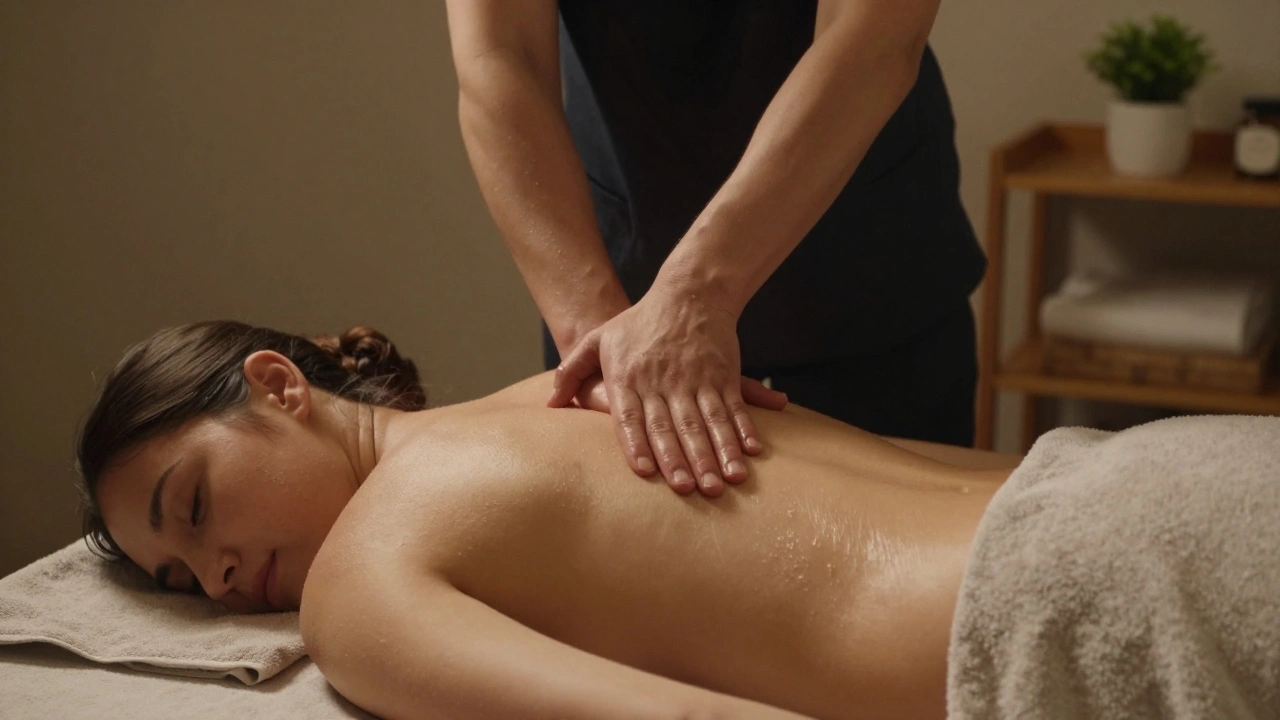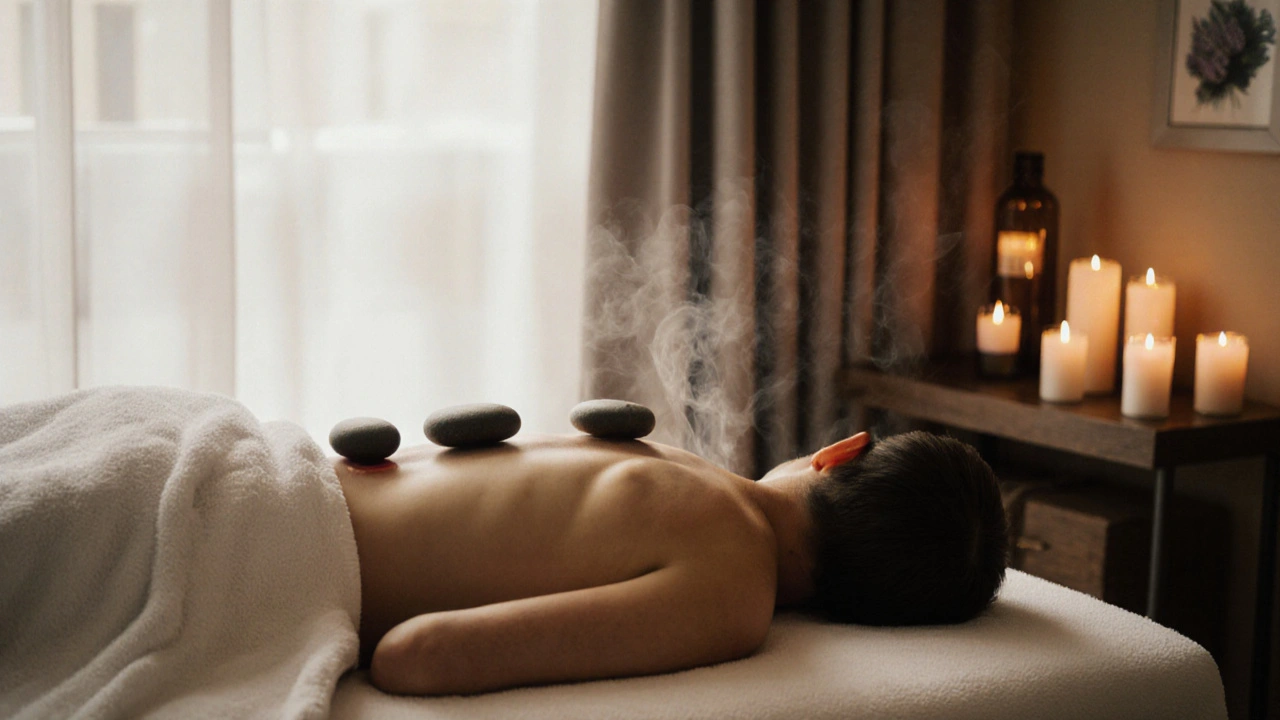Looking for authentic Thai massage in London? Discover its ancient roots, modern wellness benefits, types available, prices, tips for safe booking, and what to expect.

- Created by: Elara Wainwright
- Completed on: 27 May 2025
- Categories: Deep Tissue Massage
Ever wake up with muscles that feel like they forgot how to relax? You’re not alone. Deep tissue massage has built a name for itself as the go-to for stubborn knots and chronic aches, but its perks don’t stop there.
Picture coming out of a session feeling lighter, looser, and maybe even sleeping better that same night. That’s no fluke. From helping your body recover after workouts to dialing down everyday stress, deep tissue massage works a lot of magic beneath the surface. And it’s not just hype—there’s real science and thousands of happy client stories behind these benefits.
Stick around and you’ll get the scoop on the 10 unexpected ways this hands-on therapy can boost your mood, muscle health, and even your immune system. Plus, I’ll pull back the curtain on what actually happens during a session, so you know what to expect and how to make sure you get the most out of it.
- Key Takeaways
- Quick Answer: Why Deep Tissue Massage Is Worth It
- What Is Deep Tissue Massage – And Who Needs It?
- 10 Surprising Benefits of Deep Tissue Massage
- How to Make the Most of Your Deep Tissue Massage
- Frequently Asked Questions (FAQ)
Key Takeaways
If you’re thinking deep tissue massage only works for athletes or folks with major aches, it’s time to look again. This therapy packs a serious punch for all sorts of stress, pain, and tension—even if you’re glued to a desk all day or juggle parenting and long commutes. Here’s what really stands out about deep tissue massage:
- Deep tissue massage targets those gritty muscle knots and chronic tension you just can’t stretch away at home.
- Harvard Medical School notes that “a 60-minute massage can lower levels of cortisol, your stress hormone, and trigger feelings of comfort and calm.”
- Studies say regular sessions help improve flexibility and speed up muscle recovery, which is a game-changer whether you’re an athlete or just shoveling the driveway.
- This therapy can support pain management for issues like lower back pain, sciatica, and even migraine symptoms.
- Many folks notice better sleep and an improved mood after consistent treatments—sometimes after just a couple of sessions.
“Deep tissue massage doesn’t just loosen tight muscles—it also stimulates circulation and can kickstart the body’s natural healing process.” — American Massage Therapy Association
Take a quick look at the numbers:
| Benefit | Reported by Users (%) | Backed by Clinical Studies? |
|---|---|---|
| Pain Relief | 88% | Yes |
| Improved Flexibility | 72% | Yes |
| Stress Reduction | 82% | Yes |
| Better Sleep | 65% | Yes |
So, whether you need muscle relief, lower stress, or just want a healthier routine, deep tissue massages are much more than a luxury—they’re a smart investment in your body and mind.
Quick Answer: Why Deep Tissue Massage Is Worth It
If you’re wondering whether a deep tissue massage is worth your time or money, here’s the real answer—yes, and it’s not even close, especially if tension or nagging soreness is slowing you down. This technique goes beyond gentle rubbing; therapists dig into the deeper muscle layers and connective tissue, which is where most aches really hide out.
So, what do you actually get from it?
- Improved blood flow, which means your muscles heal faster after workouts or long days on your feet.
- Lowered pain from old injuries, chronic back issues, or even headaches. Studies show significant pain relief for folks with everything from fibromyalgia to sciatica.
- Less stiffness and better flexibility, so everyday things—like bending, lifting, or just sitting—feel easier.
- Reduction in stress and anxiety. Deep tissue work kicks up your body’s production of feel-good hormones like serotonin and oxytocin—hello, better mood!
Check out this quick table for some eye-opening stats on what people notice after getting regular deep tissue massages:
| Benefit | Reported Improvement (%) |
|---|---|
| Pain Relief | 72% |
| Better Sleep | 60% |
| More Mobility | 54% |
| Less Stress | 65% |
The upshot: If you want a hands-on way to help your body bounce back, stay active, and stress less, this style of massage could be your new best friend. Plus, it’s one of the only therapies that targets both the body and the mind together.
What Is Deep Tissue Massage – And Who Needs It?
Deep tissue massage is pretty much the heavy hitter in the massage world. Instead of just working the surface, this technique targets muscles and connective tissue much deeper below the skin. Therapists use slow, firm strokes and sometimes knuckles, elbows, or even forearms to get into those stubborn spots where tension loves to hide.
So, what really sets deep tissue massage apart from the classic Swedish style? It’s all about pressure. Swedish massage focuses on relaxation, while deep tissue is about busting through chronic knots and tightness. Think of it like upgrading from a gentle car wash to the full detail—the results go deeper.
But who’s signing up for these sessions? Here’s a quick rundown of people who can benefit the most:
- Athletes dealing with muscle soreness or injury recovery
- People with desk jobs who get back, neck, or shoulder pain
- Anyone struggling with tension headaches or jaw pain
- Folks with chronic conditions like fibromyalgia or sciatica
- People recovering from accidents or repetitive strain injuries
You don’t have to fit in one of these boxes, though. Lots of people book a deep tissue massage just because they want real relief instead of a gentle rubdown. You can even use deep tissue sessions to help with ongoing stress or trouble sleeping.
Want some hard numbers? One cool study from the Journal of Clinical Psychiatry found that people who got regular deep tissue massage reported a 36% drop in pain after just a few weeks. That’s not wishful thinking—that’s actual relief, backed by data. Here’s a look at some common reasons people get these massages and how effective it can be:
| Reason for Massage | Reported Effectiveness (%) |
|---|---|
| Chronic Lower Back Pain | 75 |
| Sports Injury Recovery | 68 |
| Stress/Tension | 61 |
| Improved Mobility | 56 |
| Sleep Quality | 53 |
Bottom line: deep tissue massage isn’t just for hardcore athletes. It’s for anyone tired of dealing with daily aches, tension, or the feeling that your muscles never really relax. The results might surprise you.

10 Surprising Benefits of Deep Tissue Massage
This isn’t just about crushing knots. Deep tissue massage offers a lot more than you’d expect, and some of these perks might catch you off guard. Check out what’s really going on behind those strong hands:
- Deep tissue massage tackles chronic pain in a big way. People with lower back pain and neck tension often notice improvement after just a couple of sessions, and some research out of Florida found it’s as effective as most pain meds—without the side effects.
- It boosts circulation. By working deep layers of muscle, it helps blood flow better, delivering extra oxygen and nutrients right where you need it. You’ll recover faster after workouts or even just after a long day at your desk.
- It speeds up muscle recovery. That’s why athletes and weekend warriors keep coming back. One study published in the Journal of Athletic Training found deep tissue massage can cut muscle soreness by 30% within 48 hours of a tough workout.
- You’ll see better range of motion. Think easier bending, stretching, and less stiff mornings. Regular sessions help keep things moving freely.
- Lower stress and anxiety aren’t just buzzwords. Real talk: Clinical trials show deep tissue lowers cortisol—the stress hormone—sometimes by 50% during a session. No wonder clients walk out feeling relaxed and rebooted.
- It can help lower blood pressure for the long haul, not just temporarily. A 2022 study found people with prehypertension had reduced blood pressure and heart rate days after their massage.
- Got headaches? Tens of thousands swear by deep tissue for relief, especially if your migraines are triggered by muscle tension.
- This massage style can help break up old scar tissue after injuries or surgery. It’s great for keeping that bumpy stiffness away so you can get back to normal activities.
- Some people notice their posture improves, since tight back or neck muscles can pull your body out of line. Loosen those up and you’ll look (and feel) less slouched.
- Sleep better, breathe deeper. There’s evidence that working out chronic tension leads to deeper sleep and may even help people with mild insomnia drift off more easily.
| Benefit | How Common? | What Science Says |
|---|---|---|
| Pain Relief | High | As effective as prescription pain meds for many people |
| Boosted Circulation | High | Improved blood flow shown in MRI scans |
| Reduced Muscle Soreness | Moderate | 30% less soreness in athletes post-massage |
| Lower Stress | High | Up to 50% drop in cortisol levels per session |
| Lower Blood Pressure | Moderate | Lasting drop measured in people with hypertension |
| Better Sleep | Moderate | Improved sleep quality reported in several studies |
So it’s not just about feeling good (though that’s reason enough). With benefits like these, deep tissue massage is a solid tool for your mental and physical health toolkit. Whether you’re dealing with everyday tension, training for a marathon, or just can’t get comfy at night, there’s a good chance you’ll walk out feeling (and moving) a lot better.
How to Make the Most of Your Deep Tissue Massage
Getting a deep tissue massage isn’t just about showing up and letting your therapist do all the work. If you want results that stick, there are a few smart moves you can make before, during, and after your session.
First up, drink plenty of water before and after your massage. Muscles love hydration, and it helps flush out toxins that get released during all that kneading. Showing up dehydrated can make your muscles feel tighter, and nobody wants that.
Before your session, think about any problem areas you want your therapist to focus on. Don’t be shy about talking through your daily routine, work setup, or any sports you play. The more your therapist knows, the better they can target the spots that bug you the most.
- Arrive at least 10 minutes early to fill out any forms and chill out—jumping straight off a crowded train into a massage isn’t ideal.
- Skip heavy meals for at least an hour before your appointment. No one wants to lie down with a belly full of pasta.
- Wear comfy clothes that are easy to change out of, since you’ll typically undress to your comfort level.
While your massage is happening, speak up if the pressure is too much or not enough. Deep tissue work can feel intense, but you should never have to grit your teeth through real pain. Communication is key—your body will thank you later.
After your massage, avoid hitting the gym hard or doing another workout. Your muscles will need a little time to recover. Mild stretching or a gentle walk is fine if you’re feeling stiff. Oh, and expect to feel a bit sore the next day—this is totally normal for some people, especially after your first session.
| Tip | Why It Matters |
|---|---|
| Hydrate before and after | Helps flush muscle waste, keeps recovery smooth |
| Share your problem areas | Therapist can focus on what matters most to you |
| Rest after your session | Allows muscles to repair and relax |
One last thing—think about booking follow-up sessions if you’re dealing with chronic issues. Studies have shown that regular massages (even once every two weeks) can cut down pain and boost flexibility more than single visits. Keep an eye on how your body feels for a few days, and don’t hesitate to ask your therapist for extra advice next time you’re on the table.
Frequently Asked Questions (FAQ)
Thinking about trying a deep tissue massage, but got questions? You’re definitely not alone. Here are the things people ask most, with simple, straight answers.
- Does deep tissue massage hurt?
It can feel intense, especially if you have tight muscles or old injuries. You shouldn’t feel real pain though—more like a strong, deep pressure. Always tell your therapist if it’s uncomfortable. They’ll adjust. - How is it different from Swedish massage?
Swedish focuses on relaxation with lighter strokes. Deep tissue goes below the surface, working out knots and tension in deeper muscle layers and connective tissues. The main goal is fixing chronic tightness and restoring movement. - How long does the effect last?
Most people feel looser for several days up to a week. If you get regular sessions, the effects tend to build up, and your body starts holding less tension by default. - What should I do after a session?
Drink plenty of water, take it easy for the rest of the day, and don’t be surprised if you feel a bit sore. A warm bath or gentle stretching may help. - Is it safe for everyone?
Most healthy adults can handle it, but you should skip it if you have certain conditions like blood clots, severe osteoporosis, or recent surgeries. Always check with your doctor when in doubt. - How much should I tip my massage therapist?
The usual tip is 15–20% of the full price, like in restaurants. Tipping is always appreciated, but not required. - How often should I book a session?
For general wellness, once or twice a month works for most. If you’re recovering from injury or training hard, you might do weekly sessions until you’re back to your old self.
Looking for some hard numbers? Here’s a snapshot based on recent surveys and medical guidelines:
| FAQ Topic | Average/Suggested Value |
|---|---|
| Session Length | 60 minutes (standard); 90 minutes for full-body or specific issues |
| Average Cost (US) | $80–$120 per session |
| Recommended Frequency | Every 2–4 weeks for maintenance; weekly for chronic cases |
| Typical Soreness Duration | 24–48 hours |
| Tipping Standard | 15%–20% |
If you have a medical condition, always give your therapist a heads-up before you start. Don’t forget to ask about anything specific to your needs—therapists are used to lots of questions and would rather you speak up than tough it out in silence.
Discover what really happens during a deep tissue massage, what to expect before, during, and after, and how it differs from other types of massage therapy for lasting pain relief.
Learn how often to get a full body massage for optimal relaxation and pain relief. Expert advice on frequency, types, pricing, and safety in London. Find out what works best for your lifestyle.



